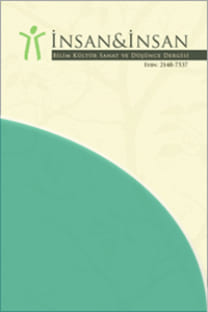Yapay Zeka Olgusunun Güncel Sanat Çalışmalarındaki Açılımları
Teknoloji ile kaçınılmaz bir ilişki içinde olan toplumdaki her birey günlük aktivitelerinin büyük bir bölümünde bilinçli veya bilinçsiz bir şekilde yapay zekânın kullanımı ve gelişimi içinde rol almaktadır. Sürücüsüz araç tasarımı, finansal analiz, bireysel eğitim uygulamaları, pazarlama analizleri, müzik ilişkilendirme uygulamaları gibi birçok faaliyet alanlarında yer alan yapay zekâ, gün geçtikçe farklı uygulama alanlarına da sirayet etmektedir. Bunun doğal bir sonucu olarak da yapay zekânın sanatla olan etkileşimleri çeşitli güncel örnekler halinde karşımıza çıkmaktadır. İnsanın düşünce sisteminin rasyonel yöntemlerle sembolize edildiği, matematiksel zeminlerde geliştirilen yapay zekânın ve varlığını tanımlanması oldukça güç olan yaratıcılık kavramı üzerine temel alan sanatın ne ölçüde birliktelikler sağlayabildiği merak konusudur. Yapay Zekâ ile elde edilen bulgular ve araştırma sonuçları ise insanın var oluşuna dair temel sorgulamaları peşi sıra körüklemektedir. Bu makalede yapay zekânın gelişimi ve kabul görülmekte olan çeşitli bilimsel tanımlar ele alınmaktadır. Ayrıca yaratıcılığın yapay zekâ ile olan ilişkisi bilişim teknolojisinin gelişimi incelenerek sorgulanmakta ve güncel sanat çalışmalarındaki etkileri incelenmektedir.
Anahtar Kelimeler:
Yapay Zekâ, Sanat, İnsan Merkezcilik, Yaratıcılık, İnsan ve Teknoloji Birlikteliği
Reflections of Artificial Intelligence in Contemporary Artworks
Each individual in the society, which is in an inevitable relationship with technology,is involved in the use and development of artificial intelligence in a large part of their dailyactivities in a conscious or unconscious manner. The artificial intelligence, which is implementedin many fields of activities such as driverless vehicle design, financial analysis, specialeducation applications, marketing analyses, music classification applications, also diverge invarious application areas. As a natural consequence of this situation, artificial intelligence’simplementations inthe art are also presented in a variety of recentartworks. It is a matter ofwonder to what extent the artificial intelligence that is relying on mathematical grounds withrational symbol systems and the art that has been based on the concept of creativity, yet whichis very difficult to define, are integrated into a well-balanced configuration. The findings andresearch results obtained by artificial intelligence are usually fueled by the basic questioningsof human existence. This article discusses the development of artificial intelligence and thevarious scientific definitions that are being widely appreciated. Moreover, the relationship ofcreativity with artificial intelligence is examined by exploring the development of informationtechnologies and its effects on contemporary artworks are investigated.
Keywords:
Artificial intelligence, Art, Anthropocentrism, Creativity, Human-technology associations,
___
- Legg, S., & Hutter, M. (2007). A collection of definitions of intelligence. Frontiers in Artificial Intelligence and applications, 157, 17.
- The compact Oxford English dictionary: Complete text reproduced micrographically. (2006). Oxford: Oxford University Press.
- Anderson, M. (1992). Intelligence and development: A cognitive theory. Blackwell Publishing.
- Fogel, D. B. (1995). Review of Computational Intelligence: Imitating Life [Book Reviews]. Proceedings of the IEEE, 83(11), 1588.
- Levitt, G. M. (2000). The Turk, Chess Automation. McFarland & Company, Inc. Publishers.
- Standage, T. (2002). The Turk: The life and times of the famous eighteenth-century chess-playing machine. Walker & Company.
- Shannon, C. E. (1950). A chess-playing machine. Scientific American, 182(2), 48-51.
- Shannon, C. E. (1950). XXII. Programming a computer for playing chess. The London, Edinburgh, and Dublin Philosophical Magazine and Journal of Science, 41(314), 256-275.
- Artut, S. H. (2018). Müzisyenin teknoloji kullanımı ile boyut kazanan görsel ve işitsel performansı. Görünüm: Sanat, Tasarım ve Sosyal Bilimler Dergisi, 3(4), 45-52.
- Bernstein, A., & de V. Roberts, M. (1958). Computer v. chess-player. Scientific American, 198(6), 96-107.
- Moravec, H. (1998). When will computer hardware match the human brain. Journal of evolution and technology, 1(1), 10.
- Kasparov, G. (2018). Deep thinking. Hodder & Stoughton.
- Silver, D., Huang, A., Maddison, C. J., Guez, A., Sifre, L., Van Den Driessche, G., ... & Dieleman, S. (2016). Mastering the game of Go with deep neural networks and tree search. nature, 529(7587), 484.
- High, R. (2012). The era of cognitive systems: An inside look at IBM Watson and how it works. IBM Corporation, Redbooks.
- Chen, Y., Argentinis, J. E., & Weber, G. (2016). IBM Watson: how cognitive computing can be applied to big data challenges in life sciences research. Clinical therapeutics, 38(4), 688-701.
- Sternberg, R. J., & Sternberg, R. J. (Eds.). (1999). Handbook of creativity. Cambridge University Press.
- Amabile, T. M. (1996). Creativity in context: Update to the social psychology of creativity. Hachette UK.
- Boden, M. A. (2004). The creative mind: Myths and mechanisms. Routledge.
- Cohen, H. (1995). The further exploits of AARON, painter. Stanford Humanities Review, 4(2), 141-158.
- Cohen, H. (1999). Colouring without seeing: a problem in machine creativity. AISB quarterly, 102, 26-35.
- Gayford, M. (2016, November 28). Robot Art Raises Questions about Human Creativity. Retrieved October 31, 2018, from https://www.technologyreview.com/s/600762/robot-art-raises-questions-about-human-creativity/
- Csikszentmihalyi, M. (2013). Creativity: Flow and the psychology of discovery and invention. New York: HarperCollins.
- P. (2018, October 25). Is artificial intelligence set to become art's next medium? | Christie's. Retrieved October 31, 2018, from https://www.christies.com/features/A-collaboration-between-two-artists-one-human-one-a-machine-9332-1.aspx
- Latour, B. (2005). Reassembling the social: An introduction to actor-network-theory. Oxford university press.
- Ferrucci, D. (2017, June 28). Machines as thought partners. Retrieved November 2, 2018, from https://www.oreilly.com/ideas/machines-as-thought-partners
- Yayın Aralığı: Yılda 2 Sayı
- Başlangıç: 2014
- Yayıncı: Okur Yazar Derneği
Sayıdaki Diğer Makaleler
İkinci Cins’te Simone De Beauvoir’ın Giyinme ve Süslenme Üzerine Çözümlemesi
15 Temmuz’a Giden Süreçte Türk Demokrasisinde Sivil Asker İlişkileri
Türk Sosyo-Kültürel Hayatına Fesin Yansıması Bağlamında Antepli Aynî’nin Divanında Fes
Sosyal Medya, Yerel Yönetimler ve Katılımcı Yönetim: Bilgi Çağında Belediyeler İçin Yeni Stratejiler
Yapay Zeka Olgusunun Güncel Sanat Çalışmalarındaki Açılımları
İstanbul’a Yönelik İç Göç Hareketlerinin Ekonometrik Analizi
Hamdi Emeç, Şenay Üçdoğruk Birecikli, Burcu Kümbül Güler
Türkiye ve İran Çağdaş Mimarisi Dönüşümünde Ulusalcı Hareketlerin Etkisi
